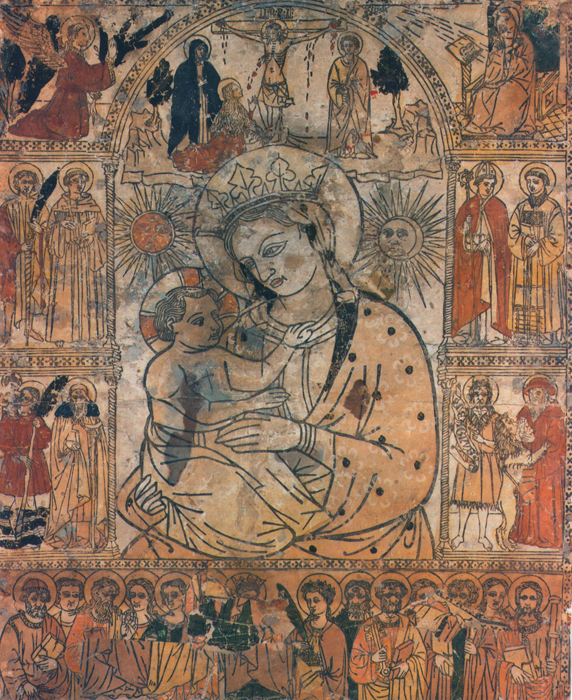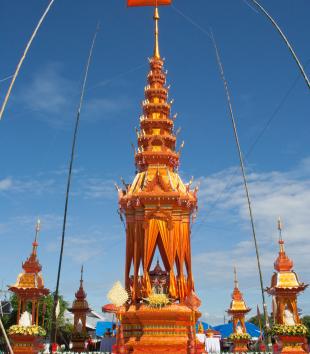Forlì's Madonna of the Fire is a large fifteenth-century woodcut almost twenty inches high and sixteen inches wide.1 Mary is at the center, a crown on her haloed head and a flowered mantle over her shoulder, as she holds Jesus in her right arm and reaches towards him with her left. The Christ child reverses her gesture, reaching above her left hand with his right, and pulling at her neckline with his left. These figures appear under an arch, the top of which is filled with a small scene of the Crucifixion; Gabriel and another image of Mary enact the Annunciation in the spandrel above it. Small paired figures of saints flank the central image of the Madonna and Child, while a row of other holy figures—now damaged and truncated—fill the space below them.
The print's status as a "religious image" is inflected by certain events in what Igor Kopytoff would call its cultural biography: its recognition and enshrinement as a miracle-working image; the kinetic rituals that moved it around the city; its multiplication and dissemination.2 Though questions about the print's earliest history—who designed, printed, or hand-colored it, where and when it was made, who first sold or bought it—now cannot be answered, we do know that by early 1428 it was tacked to a wall in a schoolhouse in Forlì, a small city southest of Bologna, and that the schoolboys, led by their teacher, Lombardino da Ripetrosa, regularly directed their prayers and lauds to it. On 4 February 1428, a terrible fire destroyed the schoolhouse, but the Madonna of the Fire was unharmed in the blaze. A seventeenth-century account tells us that "all the people" of Forlì witnessed this event, which was understood as miraculous, and the woodcut was taken to and enshrined in the city's cathedral.3 There it became the icon of a flourishing local Marian cult, and, as a fifteenth-century account says, "it makes many miracles."4
In the fifteenth century, Forlì's cathedral was undergoing major reconstruction, and the Madonna of the Fire was placed in an old chapel dedicated to Saint Bartholomew that had been part of a pre-existing church on the site. Two centuries later, Forlì's civic government repeatedly petitioned Rome for permission to build a new chapel in the cathedral dedicated to the Madonna of the Fire. By then, Forlì had been one of the Papal States continously for more than a century; at the same time, the papal bureaucracy had mobilized to promote uniform governance in its states in part by controlling local expenditure. The civic government responded to Rome's denials of its request by insisting both that their fiscal debts would soon be paid off and also that construction of the chapel was "the city's principal debt, with this Immaculate Virgin [now] finding itself in a narrow and poor little chapel."5 In this way, Forlì appealed to the pope both as its secular and its religious ruler. In 1618, the city won permission to allocate 1000 scudi in public funds to build the chapel; the rest of the necessary funding was raised in private donations.
Construction of the chapel was completed in 1636, and on 20 October of that year, a splendid procession including all of the city's major confraternities carried the Madonna of the Fire out of the old chapel of St. Bartholomew, around the city, and into its own new chapel in the cathedral. The route of this procession thus began and ended at Forlì's cultic heart, its cathedral; it encircled the oldest part of the city, the original Roman settlement along and to the south of the ancient via Emilia. Thus the icon's moving presence overtly marked the sacrality of the urban space at Forlì's historical center.
The image of the Madonna of the Fire also appeared throughout and even beyond the city. It was printed in "thousands and thousands" of impressions, molded into ceramic reliefs, painted on walls and monumental gates as well as on small pieces of cloth that her devotees carried.6 One small painting on panel was hung on an oak tree ten kilometers beyond Forlì's walls on the road to Tuscany. The painting began to work miracles in its own right, and a small roadside shrine was built there in 1629. By the early twenty-first century, the shrine was decrepit; in 2009, it was rebuilt. Like the chapel in Forlì's cathedral almost four centuries before, this new shrine "of the Madonna of the Fire in via Firenze" was the result of its local community's persistent and generous efforts.7
Notes
Notes
1. This material is drawn from my book manuscript Madonna of the Fire: A Miraculous Print in Early Modern Italy, now being revised for publication. For recent analyses of this print (with references to earlier scholarship), see Lisa Pon, "Place, Print and Miracle: Forlì's Madonna of the Fire as Functional Site," Art History 31 (2008):303-21. doi:10.1111/j.1467-8365.2008.00608.x; Sergio Fabbri, La Madonna del Fuoco di Forlì fra storia, arte e devozione (Cesena, 2003); and David Areford, The Viewer and the Printed Image in Late Medieval Europe (Burlington, VT, 2010), 10-13.
2. Igor Kopytoff, "The Cultural Biography of Things: Commoditization as Process," in The Social Life of Things: Commodities in Cultural Perspective, ed. Arjun Appadurai (Cambridge: Cambridge University Press, 1986), 64-91. doi:10.1017/cbo9780511819582.004
3. Giuliano Bezzi, Il fuoco trionfante: Racconto della traslatione della miracolosa imagine detta La Madonna del Fuoco, Protettrice della Città di Forlì (Forlì, 1637), 8.
4. Giovanni di M. Pedrino, Cronica de suo tempo, ed. Gino Borghezio and Marco Vattasso (Rome, 1929), 168.
5. Archivio di Stato, Forlì, Comune di Forlì, Consigli Generali e Secreti, 1618.
6. Bartolomeo Ricceputi, Istoria dell'immagine miracolosa di Maria Vergine detta la Madonna del Fuoco della Città di Forlì (Forlì, 1686), 77-9; Bezzi, Fuoco trionfante, 16.
7. Giovanni Panettiere, "Madonna del fuoco, la celletta torna a vivere," Il Resto del Carlino, 9 October 2009, published online at perma.cc/0gK5e2U1sqw [accessed Jan. 30, 2011].
Imprint
10.22332/con.obj.2014.14
1. Lisa Pon, "Madonna of the Fire," Object Narrative, in Conversations: An Online Journal of the Center for the Study of Material and Visual Cultures of Religion (2014), doi:10.22332/con.obj.2014.14
Pon, Lisa. "Madonna of the Fire." Object Narrative. In Conversations: An Online Journal of the Center for the Study of Material and Visual Cultures of Religion (2014). doi:10.22332/con.obj.2014.14



